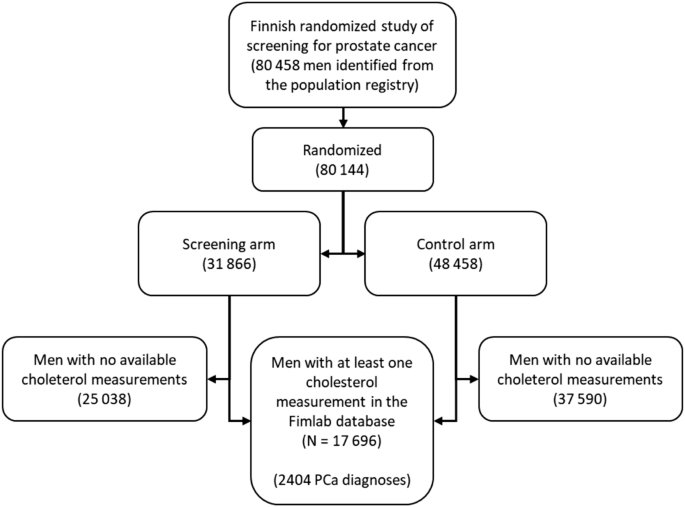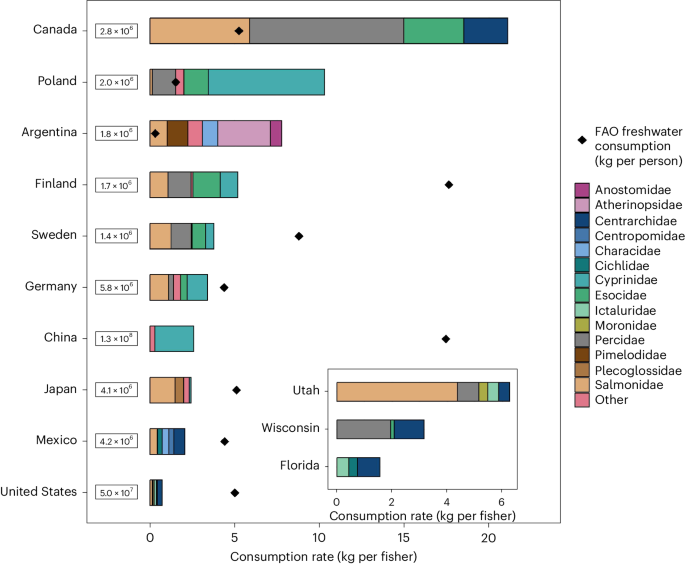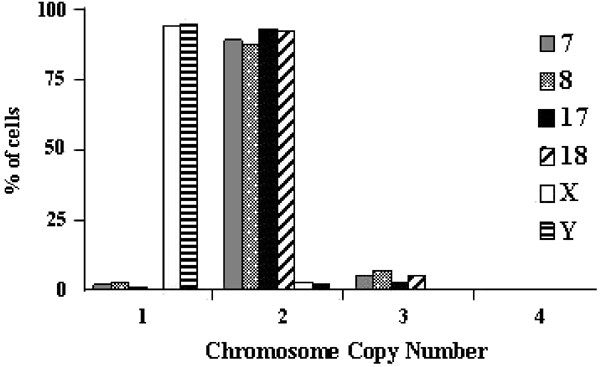
- Select a language for the TTS:
- UK English Female
- UK English Male
- US English Female
- US English Male
- Australian Female
- Australian Male
- Language selected: (auto detect) - EN
Play all audios:
ABSTRACT BACKGROUND Hypercholesterolemia has been associated with advanced stage prostate cancer (PCa), but the role of lipid parameters such as HDL and triglycerides is unclear. We examined
PCa risk by lipid parameters in a population nested within the Finnish Randomized Study of Screening for Prostate Cancer (FinRSPC). METHODS Cholesterol measurements were available on 17,696
men. During the 17-year median follow-up, 2404 PCa cases were diagnosed. Cox regression model was used to estimate hazard ratios (HR) and their 95% confidence intervals (95% CI) for overall
PCa risk and stratified by Gleason grade and tumor stage. We compared normolipidemic and hyperlipidemic men on four cholesterol parameters total cholesterol (TC), HDL, LDL, and
triglycerides (TG), analyzed as time-dependent variables. RESULTS TC in the highest tertile (above 5.1 mmol/l) and LDL above 3 mmol/l were associated with increased risk of Gleason 8–10
cancer (HR 1.42, 95% CI 1.04–1.95 and HR 1.38, 95% CI 1.02–1.86, respectively). Further, overall PCa risk was elevated in the 3-year lag time analysis by TC in the highest two tertiles (HR
1.27, 95% CI 1.05–1.54 for TC above 4.4 mmol/l, and HR 1.26, 95% CI 1.05–1.51 for TC above 5.1 mmol/l) and HDL in the highest tertile (HR 1.33, 95% CI 1.08–1.64) and above 1 mmol/l (HR 1.29,
95% CI 1.01–1.65). In contrast, TC in the highest tertile was associated with a decreased risk of PCa with 20-year lag time. The risk associations for overall PCa grew stronger with added
lag time but were observed only in the FinRSPC control arm. Statin use did not modify the risk association. CONCLUSIONS Hypercholesterolemia may increase overall PCa risk in short-term,
inverse risk association was observed with 20-years’ time lag. Similar risk increase of overall PCa was also observed for elevated HDL, conflicting with previous findings on the subject.
Access through your institution Buy or subscribe This is a preview of subscription content, access via your institution ACCESS OPTIONS Access through your institution Subscribe to this
journal Receive 4 print issues and online access $259.00 per year only $64.75 per issue Learn more Buy this article * Purchase on SpringerLink * Instant access to full article PDF Buy now
Prices may be subject to local taxes which are calculated during checkout ADDITIONAL ACCESS OPTIONS: * Log in * Learn about institutional subscriptions * Read our FAQs * Contact customer
support SIMILAR CONTENT BEING VIEWED BY OTHERS PROSTATE CANCER PROGNOSIS AFTER INITIATION OF ANDROGEN DEPRIVATION THERAPY AMONG STATIN USERS. A POPULATION-BASED COHORT STUDY Article Open
access 31 March 2021 ASSOCIATION BETWEEN LOW DENSITY LIPOPROTEIN CHOLESTEROL LEVELS AND PROSTATE CANCER RISK IN NON-HYPERTENSIVE MIDDLE-AGED AND OLDER AMERICAN MEN Article Open access 24
November 2024 UNDERSTANDING THE ROLE OF METABOLIC SYNDROME IN PROSTATE CANCER RISK: A UK BIOBANK PROSPECTIVE COHORT STUDY Article Open access 17 January 2025 REFERENCES * Krycer JR, Brown
AJ. Cholesterol accumulation in prostate cancer: a classic observation from a modern perspective. Biochim Biophys Acta. 2013;1835:219–29. CAS Google Scholar * Di Vizio D, Solomon KR,
Freeman MR. Cholesterol and cholesterol-rich membranes in prostate cancer: an update. Tumori. 2008;94:633–9. Article Google Scholar * Hager MH, Solomon KR, Freeman MR. The role of
cholesterol in prostate cancer. Curr Opin Clin Nutr Metab Care. 2006;9:379–85. Article CAS Google Scholar * Zadra G, Photopoulos C, Loda M. The fat side of prostate cancer. Biochim
Biophys Acta. 2013;1831:1518–32. Article CAS Google Scholar * Gathirua-Mwangi WG, Zhang J. Dietary factors and risk for advanced prostate cancer. Eur J Cancer Prev. 2014;23:96–109.
Article CAS Google Scholar * Clarke R, Frost C, Collins R, Appleby P, Peto R. Dietary lipids and blood cholesterol: quantitative meta-analysis of metabolic ward studies. BMJ.
1997;314:112. Article CAS Google Scholar * Whittemore AS, Kolonel LN, Wu AH, John EM, Gallagher RP, Howe GR, et al. Prostate cancer in relation to diet, physical activity, and body size
in blacks, whites, and Asians in the United States and Canada. J Natl Cancer Inst. 1995;87:652–61. Article CAS Google Scholar * Allott EH, Masko EM, Freedland SJ. Obesity and prostate
cancer: weighing the evidence. Eur Urol. 2013;63:800–9. Article CAS Google Scholar * Gong Z, Neuhouser ML, Goodman PJ, Albanes D, Chi C, Hsing AW, et al. Obesity, diabetes, and risk of
prostate cancer: results from the prostate cancer prevention trial. Cancer Epidemiol Biomark Prev. 2006;15:1977–83. Article Google Scholar * His M, Zelek L, Deschasaux M, Pouchieu C,
Kesse-Guyot E, Hercberg S, et al. Prospective associations between serum biomarkers of lipid metabolism and overall, breast and prostate cancer risk. Eur J Epidemiol. 2014;29:119–32. Article
CAS Google Scholar * Kitahara CM, Berrington de Gonzalez A, Freedman ND, Huxley R, Mok Y, Jee SH, et al. Total cholesterol and cancer risk in a large prospective study in Korea. J Clin
Oncol. 2011;29:1592–8. Article CAS Google Scholar * Martin RM, Vatten L, Gunnell D, Romundstad P, Nilsen TI. Components of the metabolic syndrome and risk of prostate cancer: the HUNT 2
cohort, Norway. Cancer Causes Control. 2009;20:1181–92. Article Google Scholar * Mondul AM, Clipp SL, Helzlsouer KJ, Platz EA. Association between plasma total cholesterol concentration
and incident prostate cancer in the CLUE II cohort. Cancer Causes Control. 2010;21:61–68. Article Google Scholar * Jacobs EJ, Stevens VL, Newton CC, Gapstur SM. Plasma total, LDL, and HDL
cholesterol and risk of aggressive prostate cancer in the Cancer Prevention Study II Nutrition Cohort. Cancer Causes Control. 2012;23:1289–96. Article Google Scholar * Van Hemelrijck M,
Garmo H, Holmberg L, Walldius G, Jungner I, Hammar N, et al. Prostate cancer risk in the Swedish AMORIS study: the interplay among triglycerides, total cholesterol, and glucose. Cancer .
2011;117:2086–95. Article Google Scholar * Arthur R, Moller H, Garmo H, Holmberg L, Stattin P, Malmstrom H, et al. Association between baseline serum glucose, triglycerides and total
cholesterol, and prostate cancer risk categories. Cancer Med. 2016;5:1307–18. Article CAS Google Scholar * Heir T, Falk RS, Robsahm TE, Sandvik L, Erikssen J, Tretli S. Cholesterol and
prostate cancer risk: a long-term prospective cohort study. BMC Cancer. 2016;16:643. Article Google Scholar * Kok DE, van Roermund JG, Aben KK, den Heijer M, Swinkels DW, Kampman E, et al.
Blood lipid levels and prostate cancer risk; a cohort study. Prostate Cancer Prostatic Dis. 2011;14:340–5. Article CAS Google Scholar * Platz EA, Clinton SK, Giovannucci E. Association
between plasma cholesterol and prostate cancer in the PSA era. Int J Cancer. 2008;123:1693–8. Article CAS Google Scholar * Platz EA, Till C, Goodman PJ, Parnes HL, Figg WD, Albanes D, et
al. Men with low serum cholesterol have a lower risk of high-grade prostate cancer in the placebo arm of the prostate cancer prevention trial. Cancer Epidemiol Biomark Prev. 2009;18:2807–13.
Article CAS Google Scholar * Mondul AM, Weinstein SJ, Virtamo J, Albanes D. Serum total and HDL cholesterol and risk of prostate cancer. Cancer Causes Control. 2011;22:1545–52. Article
Google Scholar * Salgado-Montilla J, Soto Salgado M, Surillo Trautmann B, Sanchez-Ortiz R, Irizarry-Ramirez M. Association of serum lipid levels and prostate cancer severity among Hispanic
Puerto Rican men. Lipids Health Dis. 2015;14:111. Article Google Scholar * Ahn J, Lim U, Weinstein SJ, Schatzkin A, Hayes RB, Virtamo J, et al. Prediagnostic total and high-density
lipoprotein cholesterol and risk of cancer. Cancer Epidemiol Biomark Prev. 2009;18:2814–21. Article CAS Google Scholar * Van Hemelrijck M, Walldius G, Jungner I, Hammar N, Garmo H, Binda
E, et al. Low levels of apolipoprotein A-I and HDL are associated with risk of prostate cancer in the Swedish AMORIS study. Cancer Causes Control. 2011;22:1011–9. Article Google Scholar *
Borgquist S, Butt T, Almgren P, Shiffman D, Stocks T, Orho-Melander M, et al. Apolipoproteins, lipids and risk of cancer. Int J Cancer. 2016;138:2648–56. Article CAS Google Scholar *
Farwell WR, D’Avolio LW, Scranton RE, Lawler EV, Gaziano JM. Statins and prostate cancer diagnosis and grade in a veterans population. J Natl Cancer Inst. 2011;103:885–92. Article CAS
Google Scholar * Murtola TJ, Tammela TL, Maattanen L, Huhtala H, Platz EA, Ala-Opas M, et al. Prostate cancer and PSA among statin users in the Finnish prostate cancer screening trial. Int
J Cancer. 2010;127:1650–9. Article CAS Google Scholar * Murtola TJ, Peltomaa AI, Talala K, Maattanen L, Taari K, Tammela TLJ, et al. Statin use and prostate cancer survival in the Finnish
Randomized Study of Screening for Prostate Cancer. Eur Urol Focus. 2017;3:212–20. Article Google Scholar * Crawford ED. Understanding the epidemiology, natural history, and key pathways
involved in prostate cancer. Urology. 2009;73:S4–S10. Article Google Scholar * Checkoway H, Checkoway H, Pearce N, Pearce N, Hickey JLS, Hickey JLS, et al. Latency analysis in occupational
epidemiology. Arch Environ Health. 1990;45:95–100. Article CAS Google Scholar * Sarre S, Maattanen L, Tammela TL, Auvinen A, Murtola TJ. Postscreening follow-up of the Finnish Prostate
Cancer Screening Trial on putative prostate cancer risk factors: vitamin and mineral use, male pattern baldness, pubertal development and non-steroidal anti-inflammatory drug use. Scand J
Urol. 2016;50:1–7. * Dyslipidemia. Current Care Guidelines. Working group set up by the Finnish Medical Society Duodecim and Finnish Society of Internal Medicine. Helsinki: The Finnish
Medical Society Duodecim, 2013. www.kaypahoito.fi Accessed 30 Mar 2016. * Kilpelainen TP, Pogodin-Hannolainen D, Kemppainen K, Talala K, Raitanen J, Taari K, et al. Estimate of opportunistic
prostate specific antigen testing in the Finnish Randomized Study of Screening for Prostate Cancer. J Urol. 2017;198:50–57. Article Google Scholar * YuPeng L, YuXue Z, PengFei L, Cheng C,
YaShuang Z, DaPeng L, et al. Cholesterol levels in blood and the risk of prostate cancer: a meta-analysis of 14 prospective studies. Cancer Epidemiol Biomark Prev. 2015;24:1086–93. Article
Google Scholar * Murtola TJ, Syvala H, Pennanen P, Blauer M, Solakivi T, Ylikomi T, et al. The importance of LDL and cholesterol metabolism for prostate epithelial cell growth. PLoS One.
2012;7:e39445. Article CAS Google Scholar * Wan F, Qin X, Zhang G, Lu X, Zhu Y, Zhang H, et al. Oxidized low-density lipoprotein is associated with advanced-stage prostate cancer. Tumour
Biol. 2015;36:3573–82. Article CAS Google Scholar * Schorghofer D, Kinslechner K, Preitschopf A, Schutz B, Rohrl C, Hengstschlager M, et al. The HDL receptor SR-BI is associated with
human prostate cancer progression and plays a possible role in establishing androgen independence. Reprod Biol Endocrinol. 2015;13:88. Article Google Scholar * Gutierrez-Pajares JL, Ben
Hassen C, Chevalier S, Frank PG. SR-BI: linking cholesterol and lipoprotein metabolism with breast and prostate cancer. Front Pharmacol. 2016;7:338. Article Google Scholar * Sekine Y,
Demosky SJ, Stonik JA, Furuya Y, Koike H, Suzuki K, et al. High-density lipoprotein induces proliferation and migration of human prostate androgen-independent cancer cells by an
ABCA1-dependent mechanism. Mol Cancer Res. 2010;8:1284–94. Article CAS Google Scholar * Kotani K, Sekine Y, Ishikawa S, Ikpot IZ, Suzuki K, Remaley AT. High-density lipoprotein and
prostate cancer: an overview. J Epidemiol. 2013;23:313–9. Article Google Scholar * Tall AR. Exercise to reduce cardiovascular risk—how much is enough? N Engl J Med. 2002;347:1522–4.
Article Google Scholar * Lamon-Fava S, Wilson PWF, Schaefer EJ. Impact of body mass index on coronary heart disease risk factors in men and women. Arterioscler Thromb Vasc Bio.
1996;16:1509–15. Article CAS Google Scholar Download references AUTHOR INFORMATION Author notes * These authors contributed equally: Teemu J. Murtola, Tatu V. J. Kasurinen. AUTHORS AND
AFFILIATIONS * Faculty of Medicine and Life Sciences, University of Tampere, Tampere, Finland Teemu J. Murtola, Tatu V. J. Kasurinen & Teuvo L. J. Tammela * Department of Urology,
Tampere University Hospital, Tampere, Finland Teemu J. Murtola & Teuvo L. J. Tammela * Finnish Cancer Registry, Helsinki, Finland Kirsi Talala * Department of Urology, University of
Helsinki and Helsinki University Hospital, Helsinki, Finland Kimmo Taari * Faculty of Social Sciences, University of Tampere, Tampere, Finland Anssi Auvinen Authors * Teemu J. Murtola View
author publications You can also search for this author inPubMed Google Scholar * Tatu V. J. Kasurinen View author publications You can also search for this author inPubMed Google Scholar *
Kirsi Talala View author publications You can also search for this author inPubMed Google Scholar * Kimmo Taari View author publications You can also search for this author inPubMed Google
Scholar * Teuvo L. J. Tammela View author publications You can also search for this author inPubMed Google Scholar * Anssi Auvinen View author publications You can also search for this
author inPubMed Google Scholar CORRESPONDING AUTHOR Correspondence to Teemu J. Murtola. ETHICS DECLARATIONS CONFLICT OF INTEREST The manuscript was supported by a competitive research grant
from the Expert Responsibility Area of The Pirkanmaa Hospital District to TJM. Dr. TJM has worked as a paid consultant for Astellas and Janssen-Cilag and received lecture fees from Astellas,
Janssen-Cilag, Abbvie and MSD. Dr. KT has received consulting fees from Abbvie, research funding from Medivation, and travel support from Astellas, and Orion. Professor TLJT has worked as a
paid consultant for Astellas and Janssen-Cilag, and received lecture fees from Astellas, Janssen-Cilag, Abbvie and MSD. Professor AA has received a lecture fee from MSD, and worked as a
paid consultant for Epid Research Inc. The remaining authors declare that they have no conflict of interest. ELECTRONIC SUPPLEMENTARY MATERIAL SUPPLEMENTARY TABLE 1 SUPPLEMENTARY TABLE 2
SUPPLEMENTARY TABLE 3 SUPPLEMENTARY TABLE 4 RIGHTS AND PERMISSIONS Reprints and permissions ABOUT THIS ARTICLE CITE THIS ARTICLE Murtola, T.J., Kasurinen, T.V.J., Talala, K. _et al._ Serum
cholesterol and prostate cancer risk in the Finnish randomized study of screening for prostate cancer. _Prostate Cancer Prostatic Dis_ 22, 66–76 (2019).
https://doi.org/10.1038/s41391-018-0087-0 Download citation * Received: 31 January 2018 * Revised: 26 April 2018 * Accepted: 16 May 2018 * Published: 13 September 2018 * Issue Date: March
2019 * DOI: https://doi.org/10.1038/s41391-018-0087-0 SHARE THIS ARTICLE Anyone you share the following link with will be able to read this content: Get shareable link Sorry, a shareable
link is not currently available for this article. Copy to clipboard Provided by the Springer Nature SharedIt content-sharing initiative


